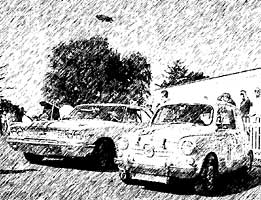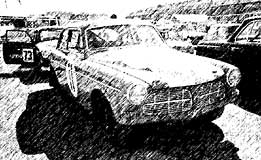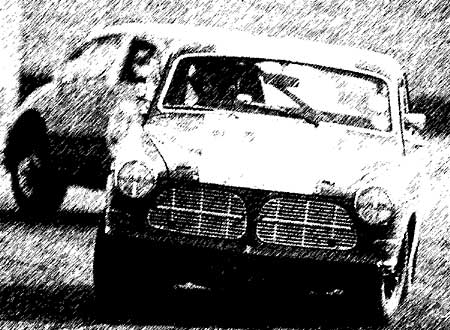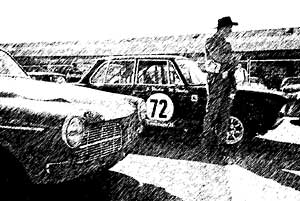The Family Race Car
Joel Wykeham
Joel.Wykeham@BBC.co.uk
Like many things in life, it seemed like a good idea at the time. After about twenty years of racing contemporary sports and saloon cars on and off,  I had gone "historic," as we say here, and decided to build and race a tiny-but-cute FIAT-Abarth 850TC. So what's that got to do with Volvos? I had gone "historic," as we say here, and decided to build and race a tiny-but-cute FIAT-Abarth 850TC. So what's that got to do with Volvos?
Well, despite it being years in the making, and after only one major event at the initial Goodwood Revival meeting, I realized there was a catch. As a road-going race car that I had to drive to the circuit, I could just squeeze myself, a set of tyres and a small toolbox inside, but absolutely nothing else. With a wife and two small kids who might conceivably like to come along too, not to mention the space requirement for a picnic hamper, it became obvious that what I needed was a family racing car. Furthermore, it had dawned on me when driving the FIAT that it might just be a good idea to have something more than the petrol tank (over my knees), two sheets of tin, and some fresh air between me and the rapidly approaching scenery. The answer was suddenly obvious: a Volvo Amazon.
Now in England Amazons are known in competition circles for one thing only and that is rallying. In this regard they are pretty successful, giving Lotus Cortinas and even Porsche 911s a run for outright honours, so it should come as no surprise in pre-1965 events. Nevertheless, I heard that certain historic rally organizers considered banning them from rallies after a few indiscretions in which some cars, allowed only 1800cc engines under the FIA rules, were found to be allegedly 2.1, 2.3 or, in the case of one Belgian PV, 2.5litres.
So the plan was simple: now would be a good time to buy a (legal) historic rally car, convert it to a race car and undertake some top historic endurance racing events that would suit its rugged and reliable personality, whilst having a trunk big enough to carry lunch plus spares and a back seat for junior passengers. Furthermore, research revealed the likes of Tom Trana had successfully raced factory cars in England in the early '60s, not to mention at the Nurburgring where I myself had been to compete at seven consecutive 24-hour races. Like I said, it seemed like a great idea at the time.
So far it has been a bit of a crash course in the ways of old Volvos in general and what's needed to make them work as historic race competition vehicles. Currently our car is the only racing Amazon I am aware of in Britain and, after just one initial "toe in the water" outing at Donington Park last year in the British round of the FIA European Historic  Touring Car championship, I am honoured to have been invited to enter the Goodwood Revival Meeting again this September. I think we are the first-ever Volvo asked to what is now established as one of the world's premier historic race meetings. Touring Car championship, I am honoured to have been invited to enter the Goodwood Revival Meeting again this September. I think we are the first-ever Volvo asked to what is now established as one of the world's premier historic race meetings.
To develop the car, we intend to partake in a new, three-part championship for pre-'66 historic sedans comprised of one-hour races with two drivers at Silverstone on May 28, Brands Hatch on July1/2 and Spa Francochamps in Belgium on September 9/10. With only two weeks to go to the first event, I am now seriously short of time, but I have at least a co-driver signed in the shape of an old school friend and one time Ferrari driver Jos Van de Perre.
Our European governing body, the FIA, has more restrictive rules for preparation than I think is true in the U.S., and understanding their bureaucratic complexity is highly important. The fact we started with a rally car has proved almost as much a hindrance as an aid and, in retrospect, I would be just as happy to have begun with a good standard road car. At least you know that way what should be normal.
So, what is this car and how are we going to make it the all-round family road racing car? In England the car's registration (license plate) number is usually for life. As I write, I am awaiting research from the central computer vehicle licensing centre in Swansea that will hopefully reveal who owned "CNA 161C" from brand-new to the present day. Incidentally, the "C" at the end of the plate tells anyone who cares to look that it was first registered in 1965.
Recent historic rally competition included the Monte Challenge and Le Jog (a Lands End to John O'Groats event) in the ownership of a Mr. Wally Wright in deepest North Yorkshire. There is just a chance this was originally a genuine Ruddspeed modified car back in the '60s. Ken Rudd was the best known British tuner of Volvos at the time, and I believe his conversions were sanctioned by the factory. Ken ran the business out of Worthing in Sussex before doing what many sensible garagistes have done: selling up at the right time and moving to an early retirement in the Caribbean.
When I bought the car, it looked ready to take on South America. The interior had more map pockets than a Norfolk jacket and the front subframe looked like it had been reinforced using plates from the battleship Potemkin. Mud was everywhere. Inspection lights were wired in everyplace, not surprising as it came with an electrician's re-wiring bill that stretched to œ1000s. Why, it had more relays than Apollo 13.
Work so far has focused on lowering and stiffening the suspension all round (a thank you to Cameron Lovre at IPD; your fabulous sway bars could have leveled the Titanic), converting the rally-spec engine to more of a three-quarter race spec. (it still has to drive to the circuit and use regular 98-octane petrol), lightening the shell where possible and/or allowed, fitting an overdrive, the usual never-ending list of smaller but essential preparation jobs and overridingly above all else trying to sort what I now know to be the Achilles heel of Amazons: the back axle.
An odd design (if I may say so) and one that, while seemingly happy bobbing up and down forest tracks in the dead of night above the Arctic circle, when shown a racetrack wants to leak, tramp, spin and ultimately break its halfshafts, by all accounts. Imagine how I felt on the standing start grid at Donington last year waiting for the lights to go green. I dropped the clutch with plenty of revs to discover little of significance happening at all. The rest of the field shot off and I waited an age for the old girl to stop bogging down, pick up her skirts and get going long after the rest. "Oh, they all do that," said the rally boys I talked to later. "Terrible off the line, always have been." The myths have started.

Since then, most of my budget has gone to having the rear axle rebuilt over and over. What started as replacing two seals has become a saga of Viking proportions. Firstly, it was decided to go for a limited-slip diff, but problems with supply and correct fitting meant three rebuilds with two different specialists. However, continued and increasing whining and graunching noises have meant a fourth rebuild currently underway with a third specialist. This time, thanks to the sound and timely advice of John Parker and David Hueppchen through Volvo Classics Interactive, I am having three-times-stronger halfshafts fitted as well. I had not previously known about the tendency this design has for them to snap just half an inch outside the bearing on the drum taper in competition use. Whilst U.S. rules allow modification of these parts to use safer Ford hubs, we are obliged to carry on with the originals. I since heard that this problem got so bad in the mid-'60s that Volvos were banned for a while from racing in Swedish championships until the factory produced an uprated shaft. However, as these carry the same part numbers as the originals, no one can be sure quite which ones they have got.
What's interesting about these cars is that, back axles apart, they do lend themselves to self preparation. Access to most areas is good, engineering is simple, effective and usually sound, parts are plentiful and prices not exorbitant. So, the original premise still holds good for the family weekend historic race car. The limitations as ever are just time, money and ultimately the fact Volvo did not know how to play the "sports options" game. If only they had homologated all the goodies such as Webers for the engine or lightweight panels like contemporaries Ford, BMW and Alfa! In the "Top Hat"challenge, we will share a class with Ford Falcons, Galaxies , Mustangs and Jaguar sedans, so let's face it we cannot compete on speed, but must aim to become the unburstable Viking tortoise.
David, John and Cameron have been a minefield of useful race prep information at long range that I hope will get us to Silverstone next week in reasonable shape. Mark Hershoren kindly has provided a copy of the original '60s U.S. Volvo tuning manual, which has acted as a fascinating benchmark and insight into how the cars were back then. Nevertheless, we would still love to find some more photographic or other reference for the cars that ran at Sebring from '63 '70, which really capture the imagination.
I should not forget to mention London Amazon expert Tony Barrett at South Service, who prepares many long-distance rally cars and has helped out with advice and parts,  plus long-time Amazon rally experts Stuart Collins and Mike Hixon in Wales, whose much-campaigned competition cylinder head now sits rebuilt upon our engine top, plus of course Keith Wilson, the rally secretary of the UK Volvo Owners Club (www.volvoclub.org.uk). They are all good contacts for visitors with Volvo or other rallying interests coming to the UK. plus long-time Amazon rally experts Stuart Collins and Mike Hixon in Wales, whose much-campaigned competition cylinder head now sits rebuilt upon our engine top, plus of course Keith Wilson, the rally secretary of the UK Volvo Owners Club (www.volvoclub.org.uk). They are all good contacts for visitors with Volvo or other rallying interests coming to the UK.
By the next time I write, Silverstone should be over and hopefully we will be on the first step of our journey back in time towards making a good show at Goodwood in September. Now, where's that picnic hamper going to fit in with everything else...
Catch up with you then.
Part two
Images styled from photos provided by Joel Wykeham
|
